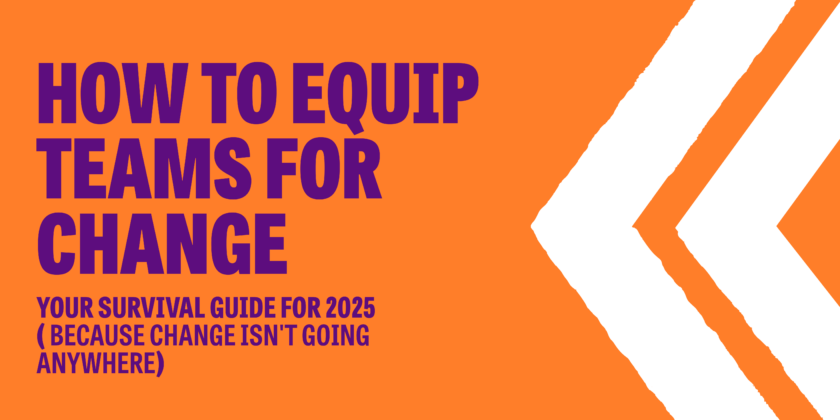Introduction
Let’s be honest – change has gone from being the occasional office drama to the main character in every business story. Digital transformations, hybrid work chaos, customer expectations that shift faster than TikTok trends, and market disruptions that pop up like unwanted ads – welcome to 2025, where “business as usual” is officially extinct.
For CHROs and HR leaders, this means one thing: getting your teams ready for change isn’t just a nice-to-have skill anymore. It’s your organisational superpower.
Here’s the not-so-fun fact that’ll make you spit out your coffee: 70% of change initiatives crash and burn. Ouch. But here’s the plot twist – organisations that actually prepare their teams properly? They’re absolutely smashing it with higher success rates, happier employees, and results that make shareholders weep tears of joy.
Ready to join the winning team? This guide is packed with practical frameworks, communication strategies that actually work, training approaches that don’t send people to sleep, and real examples from companies who’ve cracked the code. Let’s turn your organisation into a change-conquering machine.
Why Getting Your Teams Change-Ready Actually Matters (Spoiler: It’s About More Than Survival)
The business case for nailing change management isn’t just strong – it’s bulletproof. Harvard Business Review’s legendary research by John Kotter drops this mic-drop statistic: organisations that ace change management are six times more likely to hit their targets than the ones fumbling in the dark. Kotter’s 8-step model isn’t old news – it’s the playbook that keeps on giving, especially when it comes to creating urgency and getting everyone on board.
But let’s talk about what failure really costs you. It’s not just the obvious stuff like wasted tech investments, eye-watering consultant fees, and the revolving door of staff turnover. The sneaky costs are the real killers: productivity that takes a nosedive, team morale that flatlines, customers who jump ship, and watching your competitors sprint ahead while you’re still untangling the mess.
Prosci’s research serves up another reality check: projects with excellent change management are five times more likely to succeed than the train wrecks. Their ADKAR model (Awareness, Desire, Knowledge, Ability, Reinforcement) puts the spotlight exactly where it belongs – on getting individuals and teams actually ready, not just informed.
And here’s something that’ll keep you up at night: change fatigue is real, and it’s brutal. Research shows people can only juggle four major changes at once before their performance starts cracking. This isn’t just about managing one project at a time – it’s about building a culture that thrives on adaptability rather than drowning in it.
Your Change-Ready Toolkit: Strategies That Actually Work
Communication That Connects (Not Corporate Speak)
Forget the corporate jargon sandwiches – effective change communication is about being human. Prosci’s research proves that projects with stellar communication are five times more likely to succeed than those that treat communication like an afterthought.
Real communication isn’t just broadcasting what’s happening – it’s taking people on the journey. Following Kotter’s playbook means starting with the why (and making it compelling), explaining the what and when (without the fluff), showing how it affects real people doing real jobs, and keeping everyone in the loop as things unfold.
The ADKAR model gets this right: you can’t build enthusiasm for change until people actually understand why it’s necessary. This means helping your teams connect the dots between organisational success and their own growth story. When people get the ‘why’, magic happens – they become allies, not obstacles.
Two-way communication is where the real wins happen. Companies that actually listen – through pulse surveys, focus groups, and town halls that aren’t just corporate theatre – can spot trouble before it explodes. When people feel heard, they’re infinitely more likely to jump on board.
Training That Sticks (No Death by PowerPoint)
McKinsey’s research on organisational transformation hits the nail on the head: preparing teams for change means investing in capabilities that matter. Focus on three power areas: the technical skills for new ways of working, adaptive skills for navigating uncertainty, and leadership skills that turn everyone into change supporters.
Microlearning is your secret weapon here. Instead of overwhelming people with marathon training sessions during already stressful times, smart organisations break it down into bite-sized pieces that actually fit into real working life. People can learn, apply immediately, and build confidence as they go.
The Investors in People research on “Building Resilience Through Change” champions something brilliant: involving employees in decision-making and providing comprehensive support to beat change fatigue. It’s about managers becoming both technical coaches and emotional supporters.
Don’t underestimate peer power. When you create structured ways for people to learn from colleagues who’ve already navigated similar changes, you’re tapping into social learning gold. Plus, these peer networks become emotional support systems that build confidence and resilience.
Leadership That Leads (At Every Level)
Here’s what the RCVS Leadership Library research tells us: change leadership isn’t just for the C-suite. It needs to happen at every level, because employees look to their immediate bosses for cues on how to react. Middle managers are your secret change weapons.
The best change leadership strategies spell out exactly who does what. Executive sponsors provide direction and resources, change champions become cheerleaders within their teams, and project managers keep everything coordinated. When everyone knows their role, teams feel confident and supported.
Change champions deserve special mention – these are your organisational superheroes. They’re the respected team members who get excited about change and become bridges between leadership and the front lines. Give them extra training, regular leadership updates, and recognition for their efforts. They’re worth their weight in gold.
Project Management That Actually Manages Projects
IMD’s research on “Everything You Need to Know About Change Management in 2025” drives home a crucial point: treating change like a proper project dramatically improves your odds of success.
Start with comprehensive planning that identifies everyone who’s affected, assesses how ready people are for change, and creates detailed roadmaps. Include risk assessment that spots potential problems and plans how to handle them. Companies that invest in proper planning see significantly better results than those that wing it.
Resource allocation matters more than you think. Change management activities need dedicated time and protected resources, just like any other project deliverable. Many initiatives fail simply because organisations underestimate the effort required for the people side of transformation.
Measuring What Matters
Track both the end results (project completion, benefits realised) and the early indicators that predict success (engagement levels, adoption rates). The most valuable metrics focus on whether people are actually changing how they work, not just whether they attended training sessions.
Multiple research sources agree: feedback loops and meaningful metrics are non-negotiable. Employee feedback through pulse surveys, focus groups, and proper conversations provides crucial intelligence about what’s working and what needs fixing.
Real-World Heroes: Companies Getting It Right
Microsoft’s Cultural Revolution
Microsoft’s transformation under Satya Nadella is a masterclass in systematic team preparation. Facing the need to shift from a “know-it-all” to a “learn-it-all” culture, they invested massively in preparing teams for fundamental change, demonstrating Kotter’s 8-step model in action.
They started crystal clear: this cultural shift was essential for thriving in the cloud era. Leadership consistently championed growth mindset, collaboration, and customer obsession through every channel possible – pure ADKAR model brilliance in building awareness and desire.
Microsoft’s training approach was genius: they developed both technical skills and cultural capabilities. Extensive manager training helped leaders model new behaviours and support their teams. Peer learning networks let employees share experiences and best practices for implementing cultural changes.
Digital Transformation Done Right
A leading UK financial services organisation recently nailed a major digital transformation that touched employee roles, customer interactions, and internal processes. Their secret? Extensive stakeholder engagement from day one, following McKinsey’s team-based transformation principles.
They started with comprehensive change readiness assessments that identified specific support needs for different groups. Then they created targeted interventions addressing technical training, emotional support, and career development concerns – straight from the Investors in People playbook on building resilience.
Their communication strategy included regular updates through multiple channels, structured listening sessions, and transparent progress reporting. A robust change champion network provided local support and feedback collection throughout.
The results? Customer satisfaction soared, employee engagement stayed strong throughout the transition, and they smashed their efficiency targets. Systematic team preparation was the game-changer.
Public Sector Success Story
A major UK government department tackled the challenge of transforming service operations while maintaining critical public services. This transformation required significant changes in roles and processes, demonstrating RCVS Leadership Library principles of managing change with emotional intelligence.
Their approach included comprehensive readiness assessments and targeted support programmes. Communication emphasised transparency and regular engagement, while training combined formal programmes with peer support networks connecting employees across regions implementing similar changes.
They achieved their objectives while maintaining high engagement scores throughout – proof that systematic team preparation can deliver complex change without disrupting critical services.
Your Change Management FAQ (The Questions Everyone’s Actually Asking)
- What are the most effective models for managing team change?
- How can we prepare teams to adapt to change?
- What role does communication play in equipping teams for change?
- How do you address resistance to change within teams?
- What training or support should be provided during change?
- How can we measure the success of change initiatives at the team level?
- What are common pitfalls in equipping teams for change?
The Bottom Line: Change Champions Win
Equipping teams for change has officially graduated from “nice-to-have” to “absolutely essential” in 2025. The evidence is crystal clear: organisations that systematically prepare their teams for transformation absolutely demolish those that treat change management as an afterthought.
The strategies we’ve covered – human communication, targeted training, leadership at every level, proper project management, and meaningful measurement – aren’t just tactics. They’re your comprehensive framework for building teams that thrive on change rather than survive it.
The most successful organisations treat change management as an ongoing investment in capability, not a project expense. They build change resilience that serves multiple transformations over time, creating competitive advantages that compound as they navigate an increasingly dynamic business environment.
The organisations that thrive in 2025 and beyond will be the ones that have mastered the art and science of equipping teams for change. By implementing these strategies and learning from these examples, HR leaders can position their organisations for sustained success in an era where transformation never stops.
Ready to turn your organisation into a change-conquering machine? At Let’s Talk Talent, we specialise in helping organisations build change-ready teams and implement transformation initiatives that actually work. Our experienced consultants partner with HR leaders to develop comprehensive change management strategies that deliver real results.
Discover how our change and transformation services can help your organisation succeed
AI Share



